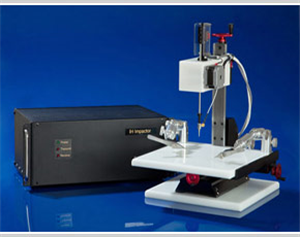

IH-0400 Spinal Cord Impactor
DISCONTINUED - A Contusion device specifically designed for medical research using rats and mice
- Overview
- Specifications
- Accessories
- Citations
- Related Products
Overview
DISCONTINUED
SEE NEW VERSION IH-0415
PSI engineers developed a contusion device designed specifically for research using rats and mice. The system provides researchers specializing in spinal cord injuries with a unique tool to evaluate the mechanisms underlying injury to spinal cord structures.
This instrument enables the application of computer controlled standard-force injuries to the spinal cords of small rodents. Force levels are user-selectable between 30 and 300 kilodynes. The impact tip can also be halted to dwell at a specific force level to model extended compression injuries.
Real-time probe force and displacement graphs provide the operator with a precise detailed record of the kinematics of each impact. Combined with a Windows 10 PC, tip force and position are plotted as a function of time and displayed on the PC. The data can be recorded in a log file along with any other experiment parameters specified by the user. The experiment data and impact curves can be recalled to review experiments. The system is ready to use out of the box and requires minimal training to achieve precise, consistent impacts.
Specifications
Impactor:
- Maximum height — 19" (483mm)
- Desk top foot print X by Y — 24" (610mm) by 16" (407mm)
- Weight 30 lbs
- Power train, position sensor and force sensor installed
- 3 - 6' (1.8m) cables
- 3 axis manual position control
- X — Range: 8" (228mm)
- Y — Range: 3" (76mm)
- Z — Range: 3" (76mm)
- Z axis auto range — .63" (16mm)
- Removable 12" (305mm) x 12" (305mm) fixation plate
- Addson micro- forceps (Sterilizing Forceps: 1. Rinse forceps in warm water; 2. Dry them; 3). Place in hot bead sterilizer for 10 seconds or place them in an iodine solution for 30 seconds. DO NOT STERILIZE IN AUTOCLAVE.)
- 12" (305mm) x 12" (305mm) base
Control Cabinet:
- Control cabinet 19" (483mm) x 8-3/4" (222mm) x 15" (380mm)
- Weight 45 lbs
- 120/240VAC 50/60Hz 10AMP
Removable impact tips
- Standard mouse tip size — 1.3mm
- Standard rat tip size — 2.5mm
- Custom tip sizes made to order
System Software:
- Windows 10 compatible PC.
- Programmable force levels 30 to 300 kilodynes
- Programmable dwell time
- Display: Peak force, Displacement in tissue, Impact velocity, Force and Displacement graphs vs time.
- Log file for experiment data archive and recall.
Accessories
Citations
Adjan, V.V., Hauser, K.F., Bakalkin, G., Yakovleva, T., Gharibyan, A., Scheff, S.W., Knapp,
P.E. (2007). Caspase-3 activity is reduced after spinal cord injury in mice lacking
dynorphin: differential effects on glia and neurons. Neuroscience 148, 724-736.
Anderson, K.J., Fugaccia, I., Scheff, S.W. (2003). Fluoro-jade B stains quiescent and reactive
astrocytes in the rodent spinal cord. Journal of neurotrauma 20, 1223-1231.
Baker, K.A., Hagg, T. (2005). An adult rat spinal cord contusion model of sensory axon
degeneration: the estrus cycle or a preconditioning lesion do not affect outcome. Journal
of neurotrauma 22, 415-428.
Basso, D.M., Fisher, L.C., Anderson, A.J., Jakeman, L.B., Mctigue, D.M., Popovich, P.G.
(2006). Basso Mouse Scale for locomotion detects differences in recovery after spinal
cord injury in five common mouse strains. Journal of neurotrauma 23, 635-659.
Cain, L.D., Nie, L., Hughes, M.G., Johnson, K., Echetebu, C., Xu, G.Y., Hulsebosch, C.E.,
Mcadoo, D.J. (2007). Serum albumin improves recovery from spinal cord injury. Journal
of neuroscience research 85, 1558-1567.
Cao, Q., Zhang, Y.P., Iannotti, C., Devries, W.H., Xu, X.M., Shields, C.B., Whittemore, S.R.
(2005a). Functional and electrophysiological changes after graded traumatic spinal cord
injury in adult rat. Experimental neurology 191 Suppl 1, S3-S16.
Cao, Q., Xu, X.M., Devries, W.H., Enzmann, G.U., Ping, P., Tsoulfas, P., Wood, P.M., Bunge,
M.B., Whittemore, S.R. (2005b). Functional recovery in traumatic spinal cord injury after
transplantation of multineurotrophin-expressing glial-restricted precursor cells. J
Neurosci 25, 6947-6957.
Cheng, X., Wang, Y., He, Q., Qiu, M., Whittemore, S.R., Cao, Q. (2007). Bone morphogenetic
protein signaling and olig1/2 interact to regulate the differentiation and maturation of
adult oligodendrocyte precursor cells. Stem cells (Dayton, Ohio) 25, 3204-3214.
Crown, E.D., Ye, Z., Johnson, K.M., Xu, G.Y., Mcadoo, D.J., Westlund, K.N., Hulsebosch, C.E.
(2005). Upregulation of the phosphorylated form of CREB in spinothalamic tract cells
following spinal cord injury: relation to central neuropathic pain. Neuroscience letters
384, 139-144.
Engesser-Cesar, C., Anderson, A.J., Basso, D.M., Edgerton, V.R., Cotman, C.W. (2005).
Voluntary wheel running improves recovery from a moderate spinal cord injury. Journal
of neurotrauma 22, 157-171.
Enzmann, G.U., Benton, R.L., Talbott, J.F., Cao, Q., Whittemore, S.R. (2006). Functional
considerations of stem cell transplantation therapy for spinal cord repair. Journal of
neurotrauma 23, 479-495.
Fee, D.B., Swartz, K.R., Joy, K.M., Roberts, K.N., Scheff, N.N., Scheff, S.W. (2007). Effects of
progesterone on experimental spinal cord injury. Brain research 1137, 146-152.
Loy, D.N., Sroufe, A.E., Pelt, J.L., Burke, D.A., Cao, Q.L., Talbott, J.F., Whittemore, S.R.
(2005). Serum biomarkers for experimental acute spinal cord injury: rapid elevation of
neuron-specific enolase and S-100beta. Neurosurgery 56, 391-397; discussion 391-397.
Mcewen, M.L., Sullivan, P.G., Springer, J.E. (2007). Pretreatment with the cyclosporin
derivative, NIM811, improves the function of synaptic mitochondria following spinal
cord contusion in rats. Journal of neurotrauma 24, 613-624.
Nesic-Taylor, O., Cittelly, D., Ye, Z., Xu, G.Y., Unabia, G., Lee, J.C., Svrakic, N.M., Liu, X.H.,
Youle, R.J., Wood, T.G., Mcadoo, D., Westlund, K.N., Hulsebosch, C.E., Perez-Polo,
J.R. (2005). Exogenous Bcl-xL fusion protein spares neurons after spinal cord injury.
Journal of neuroscience research 79, 628-637.
Nesic, O., Lee, J., Ye, Z., Unabia, G.C., Rafati, D., Hulsebosch, C.E., Perez-Polo, J.R. (2006).
Acute and chronic changes in aquaporin 4 expression after spinal cord injury.
Neuroscience 143, 779-792.
Nesic, O., Lee, J., Johnson, K.M., Ye, Z., Xu, G.Y., Unabia, G.C., Wood, T.G., Mcadoo, D.J.,
Westlund, K.N., Hulsebosch, C.E., Regino Perez-Polo, J. (2005). Transcriptional
profiling of spinal cord injury-induced central neuropathic pain. Journal of
neurochemistry 95, 998-1014.
Nessler, J.A., De Leon, R.D., Sharp, K., Kwak, E., Minakata, K., Reinkensmeyer, D.J. (2006).
Robotic gait analysis of bipedal treadmill stepping by spinal contused rats:
characterization of intrinsic recovery and comparison with BBB. Journal of neurotrauma
23, 882-896.
Nishi, R.A., Liu, H., Chu, Y., Hamamura, M., Su, M.Y., Nalcioglu, O., Anderson, A.J. (2007).
Behavioral, histological, and ex vivo magnetic resonance imaging assessment of graded
contusion spinal cord injury in mice. Journal of neurotrauma 24, 674-689.
Rabchevsky, A.G., Fugaccia, I., Sullivan, P.G., Scheff, S.W. (2001). Cyclosporin A treatment
following spinal cord injury to the rat: behavioral effects and stereological assessment of
tissue sparing. Journal of neurotrauma 18, 513-522.
Scheff, S.W., Rabchevsky, A.G., Fugaccia, I., Main, J.A., Lumpp, J.E., Jr. (2003). Experimental
modeling of spinal cord injury: characterization of a force-defined injury device. Journal
of neurotrauma 20, 179-193.
Swartz, K.R., Fee, D.B., Joy, K.M., Roberts, K.N., Sun, S., Scheff, N.N., Wilson, M.E., Scheff,
S.W. (2007). Gender differences in spinal cord injury are not estrogen-dependent. Journal
of neurotrauma 24, 473-480.
Tarasenko, Y.I., Gao, J., Nie, L., Johnson, K.M., Grady, J.J., Hulsebosch, C.E., Mcadoo, D.J.,
Wu, P. (2007). Human fetal neural stem cells grafted into contusion-injured rat spinal
cords improve behavior. Journal of neuroscience research 85, 47-57.







Request
Catalogue
Chat
Print